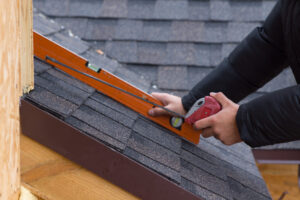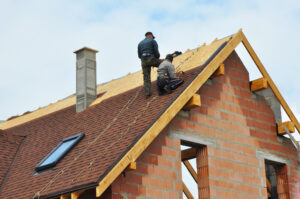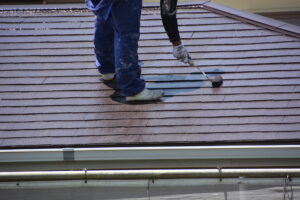Did you know that the roofing industry was worth over $40,000 million this year, and around $50 million last year? It’s not a surprise, considering that it’s not really possible to live with a roof leak—so if someone has one, they’re likely to hire someone in the roofing industry.
If you have a leaking roof, you need the best roof repair advice to find the leak and patch it, whether you’re repairing it or an expert.
If you don’t have the right tips, then you can end up with dangerous, expensive flooding damage—or take so long to fix the problem that you spend a huge amount on a repair instead of having dealt with the problem early enough to save money.
It’s a difficult situation to find yourself in, particularly because it’s time-sensitive, trying to fix a leak in the roof. Luckily, we’ve put this guide together. By presenting you with 12 roof repair tips to find and replace a leaky roof, you can avoid leaks yourself—no expertise needed.
We’ll teach you how to track down and repair the most common forms of roof leaks. Many leaks require just a few minutes to fix. Read on to learn more about it.
Leaky Roof Overview
The first step in repairing the leak is to note that there are water stains in your house. If you see them above you on the ceiling or leave a moist spot on the walls, then the source is a leaky roof.
The next step in making a leaky roof overview is to recognize where it’s coming from. It’s crucial that you do this immediately because holding it off will destroy your ceilings, create mold problems, and ruin the insulation in your house.
Deal with the issue right now, starting with figuring out where the roof leak is coming from.
How to Find Roof Leaks
When it comes to repairing a leaky roof, you need to know how to find roof leaks.
This is where the leak originated on the wall or ceiling. Then you should look at the roof itself, above where the leak is inside your house.
These items can include dormers, chimneys, roof vents, and even plumbing. Often the source may be a tree branch or other heavy object.
If you don’t have an attic, you’re going to have to climb up the roof to figure out where the damage is and what prompted it.
A Trick for Finding Difficult Leaks
A trick for finding difficult leaks when investigating a roof leak is to cause the leak yourself. This may sound counter-intuitive, but with the right support and your day-to-day garden home, you can quickly find where the infiltration of your roof has happened.
Have a partner come by to go in to see the evidence of the spill. Then climb up to your roof with your garden hose and spray areas in the general area where you suspect there’s a leak.
Solution for a Small Leak
There’s a special solution for a small leak when you’re doing your roof repair because they’re so difficult to identify. This solution is to look for ‘shiners,’ which are nails that didn’t go through the frame correctly. You can find them in your attic.
If any of these nails have water that drips from them, even one small drop, then that’s where your leak is. By using side-cutting pliers, you can cut the nail and stop the leak.
Fix Plumbing Vent Boots
Frequently, plumbing vent boots will crack and break, causing a leak that extends to the rest of your house. To repair the plumbing vent boots and save your leaking roof from leaking, you’re going to want to take a close look at them.
If this is the case, you’ll need to remove the shingles and reattach the plumbing vent boots properly. While doing this, be careful with the shingles, so that you won’t have to shell out money for new ones.
How to Fix Roof Vents
If you find that your roof vents are broken, you might think of how to fix roof vents. But this isn’t how to repair your roof. If there’s any damage to them, whether the cause is age or a recent storm, they’re going to need to be replaced.
Unfortunately, caulk won’t fix this problem; eventually, the water will get through and the leak will start again.
Instead, you need to replace the vents and use rubber-washer screws so that you can minimize a second leak happening with the new vents.
Fix Walls and Dormers
When you find out how to repair your roof, you might believe that all the leaks come in through the roof. However, this is not always the case. You can need to repair walls and dormers to avoid any damage to your house.
If the leak doesn’t show on your ceiling, but actually on the side of your building, you’re going to have to patch the walls and the dormers.
Complex Roof Problem
There’s a complicated roofing issue that can occasionally spark a leak. This seasonal challenge is called an ice dam, which can form at any moment of heavy snowfall. Basically, if there’s a lot of snowfall, you can build up on your roof and construct a dam.
This dam doesn’t cause the water to come out of your house, which means the melting ice water pools are steadily gathering on your roof.
This will lead to a leak if the dam remains there for too long. You’ll need to place an adhesive ice-and-water barrier between the shingles and the sheathing underneath to solve this problem. This will therefore avoid the issue from arising in the future.
Fix Step Flashing
Perhaps a leak can be triggered by step flashing that has been worn down by the environment or time. Step flashing is a piece of material that is used to cover the unshingled wall or roof that touches the shingles on the roof. If water pours out of the shingles, it goes through the step flashing instead of heading through the unshingled area.
To fix this issue, remove the old step flashing and consider replacing it. It’s a bit of a complex operation, so you may want to consider finding a specialist to do it for you.
Don’t Count on Caulk!
It might be enticing to use caulk to patch a leak, but it’s just going to work for so long. Even though caulk can be prosecuted over several repairs, the combined force of water and gravity ensures that the leak will inevitably work through.
For both of these replacements, you’re going to have to rebuild portions of your house instead of just fixing the holes with the caulk.
Fix Small Holes
If you want to fix a small hole by plugging it up with caulk—well, didn’t we already tell you? Don’t use caulk. Because it’s a small hole, it may seem to make sense to fix it with a small fix.
These small holes, which can appear because of a removed nail or an old satellite dish that was uninstalled, can cause big problems when it comes to leaks. Fortunately, there is a solution: flashing. Install it where the leak is, and you won’t have a leak anymore.
Leaks Around Brick Chimneys
Brick chimneys, though they mean you can enjoy a beautiful fire in the middle of a winter storm, have the potential of causing disastrous leaks. Often, the flashing protecting the chimney rusts over, which means you’ll get a leak.
To fix this, you need to replace the flashing. Using flashing that’s specially designed for chimneys is the way to go.
Need More Roof Repair Tips?
Need more roof repair tips? Or information on how much repairs might cost? Whatever your question, we’ve got the answer. Here at Hulsey Roofing Co., we’re experts on anything related to roofing.
If you have questions or want to learn about our services, visit our contact us page.





